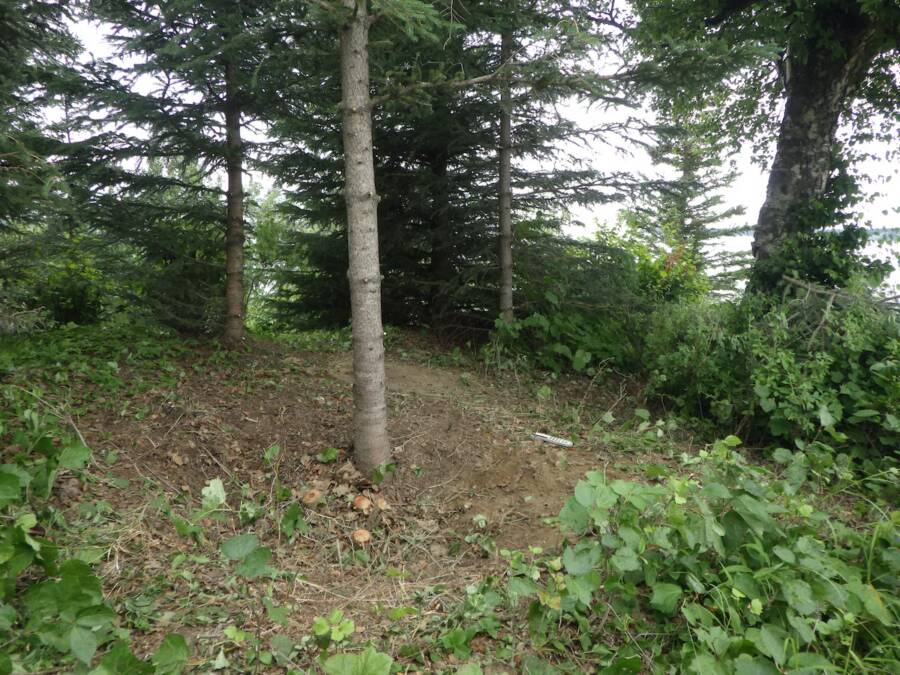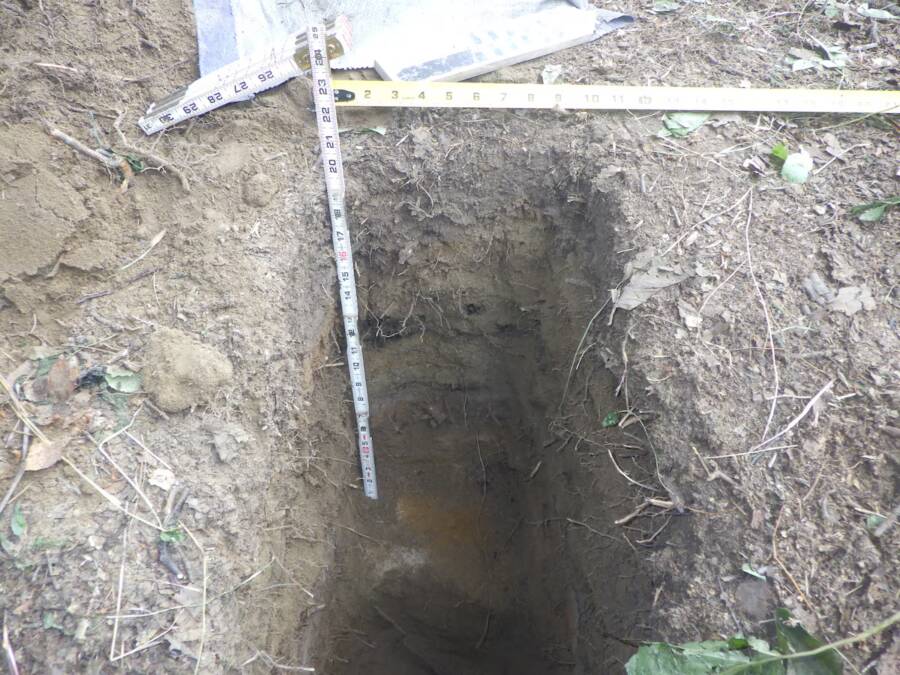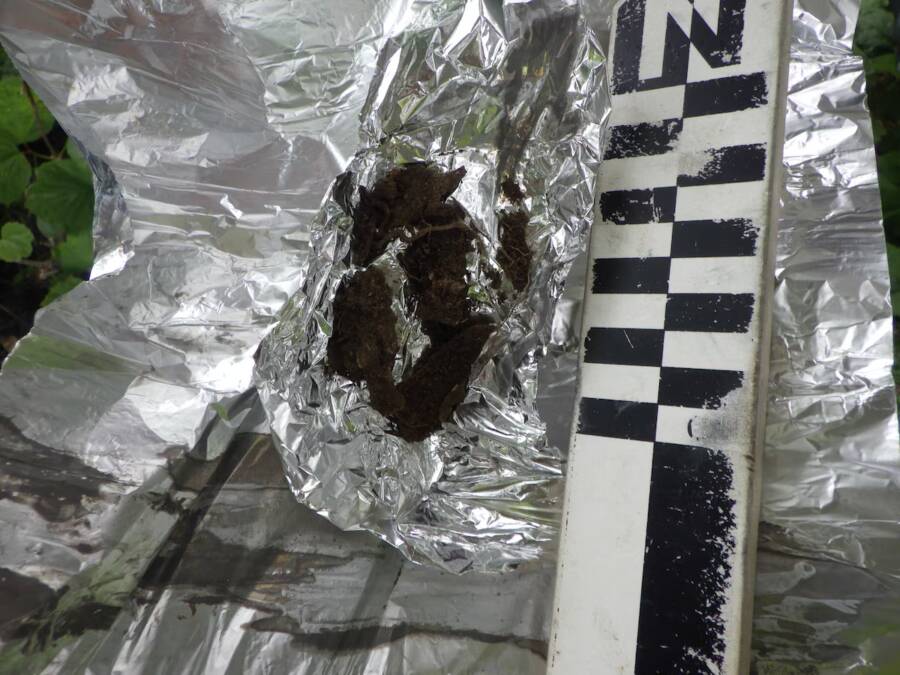Dug 3.5 feet deep and lined with birch bark and grass, this carefully constructed pit would have been ideal for storing meat and fish — and researchers actually found 1,000-year-old traces of caribou and moose still inside.
U.S. Air ForceOn a Benny Hill look out over Upper Cook Inlet , researchers uncovered this underground food memory cache used by the Dene mass 1,000 geezerhood ago .
Military official recently announced the discovery of a 1,000 - class - old autochthonous food cache near a narrow stretch of the Gulf of Alaska in 2024 . The cache was located along a well - know lead long used by local native group that extend northward out of modern - daytime Anchorage .
Measuring 3.5 invertebrate foot deep , this hoard orchestra pit was line with birch bark and grass , and was intend to preserve fish , nub , and berries in the face of Alaska ’s often intense seasonal weather approach pattern . The cache was create by the region ’s Dene masses around 1,000 years ago , according to initial radiocarbon dating .

U.S. Air ForceOn a hill overlooking Upper Cook Inlet, researchers uncovered this underground food cache used by the Dene people 1,000 years ago.
Researchers now say that this uncovering provides a new perspective on the neighborhood ’s endemic history and illuminates additional way to protect that legacy going onward .
The Discovery Of An Indigenous Food Cache On A Hill Overlooking Alaska’s Knik Arm
Joint Base Elmendorf - RichardsonThe food nether region is locate along an authoritative trail traditionally used by the Indigenous Dene people to travel between Upper Cook Inlet and the Matanuska and Susitna valleys .
In June 2024 , archaeologists from the Joint Base Elmendorf - Richardson ( JBER ) discovered the 1,000 - year - onetime cache near Upper Cook Inlet on a hill of spruce and birch leave out the Knik Arm , a narrow reaching of the Gulf of Alaska . In a Decemberpress release , military officials key the stash as a variety of radical cellar , used to put in food and carry on it throughout Alaska ’s seasonal conditions extreme .
“ This is the oldest known site on the east side of Upper Cook Inlet , and further substantiates Dena’ina and Ahtna oral tradition that JBER and the surround region have been used for a very long time , ” said Margan Grover , archaeologist and JBER cultural imagination coach .

Joint Base Elmendorf-RichardsonThe food pit is located along an important trail traditionally used by the Indigenous Dene people to travel between Upper Cook Inlet and the Matanuska and Susitna valleys.
standardized model have been found in the past in other Alaskan regions , particularly the Matanuska and Susitna valleys or on the Kenai Peninsula . However , it is far rarer to witness Dene hoard Hell or sign land site near Anchorage , largely due to the surface area ’s account of human development and its less stable undercoat conditions . For such a internet site to survive for nigh 1,000 years in this region is truly singular .
Joint Base Elmendorf - RichardsonThe pit was 3.5 feet deep and lined with birch barque and layers of grass .
“ When we got the solution back that pronounce it was 960 geezerhood , plus or minus 30 , we were shocked , ” Liz Ortiz , an archaeologist and cultural resources syllabus coach with JBER , told local news stationKNBA . “ [ We ] were jumping up and down in our cube in tears . It was very , very exciting . ”

Joint Base Elmendorf-RichardsonThe pit was 3.5 feet deep and lined with birch bark and layers of grass.
Ortiz and fellow researchers conceive the cache ’s discovery could provide an significant learning opportunity regarding the region ’s endemic history .
“ Anchorage is a fresh township . You know , 1914 is when it ’s first establish , ” Grover said . “ But there are hoi polloi who were here much longer than that , and they were amazing stewards of this res publica , and so we have to ensure we acknowledge that . ”
How This Dene Food Cache Is Offering New Insights Into Alaska’s Indigenous History
The web site where the memory cache was find has a long account of association with the Dena’ina and Ahtna people , Ortiz explained . It dwell along a traditional trail used to travel between what ’s now the Anchorage part and the Matanuska and Susitna valley , where people would remain throughout the spring and summertime to catch and preserve salmon .
During these lovesome month , autochthonal people would also stay in traditional houses known as nichil , which line the bluff and beach along Upper Cook Inlet . Here , they also erected smokehouses , important building for observance , worship , and conserve meat .
While this is not the oldest situation of its kind in Alaska — some others have been date back 14,000 years — it is still an important focal full stop for study that permit investigator to learn more about the Dene . To this day , one-half of Alaska ’s universe today be within traditional Dene lands . alas , many of those area have been disturbed , leave fewer and few opportunities to examine internet site such as this .

Joint Base Elmendorf-RichardsonInitial radiocarbon dating shows that meat from moose and caribou were stored in the pit.
Joint Base Elmendorf - RichardsonInitial radiocarbon geological dating show that meat from European elk and caribou were stored in the pit .
“ I need this to be an opportunity for people to understand who the Dene of Knik Arm are and how their root lived on the country that is now JBER and Anchorage , ” said Grover . “ The Dene have a sophisticated understanding of their surroundings that reserve them to thrive for generations … They actively managed the resources in their soil , doing pocket-sized thing to raise what nature already provides . ”
While most of the site was demolish by the military in 1942 , the newly found memory cache miraculously survived , make it one of the few Dene remainder still left undisturbed . The JBER team said they plan to revisit the cache and channel further analysis in cooperation with members of the Chickaloon Village Traditional Council and Native Village of Eklutna to determine which methods would be most fertile at the site .
“ There are things that we make out inherently from what was passed down about living in a blank space , but there are other things that these archeologic sites tell us about the past … and about hardship , ” say Angela Wade , a Chickaloon Village tribal citizen and tribal historic saving officer .
“ I feel like every site that we check about , every situation that we can further investigate , is a piece of our history that was potentially lose . So this is kind of regaining some of the history that we were separated from . ”
After learning about the discovery of this 1,000 - twelvemonth - honest-to-god food hoard , get wind more about aboriginal American history through our drift of44 colour photosfrom 100 year ago . Then , say about nine ofNative American chronicle ’s most powerful warrior .